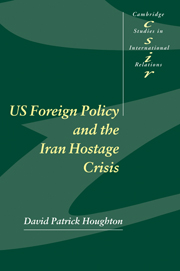Book contents
- Frontmatter
- Contents
- Preface
- 1 Jimmy Carter and the tragedy of foreign policy
- 2 Locating the argument: a review of the existing literature
- 3 The origins of the crisis
- 4 The waiting game
- 5 Days of decision: the hostage rescue mission
- 6 Hostages to history
- 7 Some alternative explanations: non-analogical accounts of the Iran decision-making
- 8 Conclusion
- Appendix 1 Dramatis personae
- Appendix 2 The major historical analogies used
- Bibliography
- Index
- CAMBRIDGE STUDIES IN INTERNATIONAL RELATIONS
5 - Days of decision: the hostage rescue mission
Published online by Cambridge University Press: 22 September 2009
- Frontmatter
- Contents
- Preface
- 1 Jimmy Carter and the tragedy of foreign policy
- 2 Locating the argument: a review of the existing literature
- 3 The origins of the crisis
- 4 The waiting game
- 5 Days of decision: the hostage rescue mission
- 6 Hostages to history
- 7 Some alternative explanations: non-analogical accounts of the Iran decision-making
- 8 Conclusion
- Appendix 1 Dramatis personae
- Appendix 2 The major historical analogies used
- Bibliography
- Index
- CAMBRIDGE STUDIES IN INTERNATIONAL RELATIONS
Summary
Jimmy Carter clearly deferred to his secretary of state's pro-negotiation strategy initially. As Gary Sick notes, with only a couple of exceptions, ‘Secretary Vance and the Department of State thoroughly dominated the US decision-making process during the first two months of the crisis’. Vance argued with success that the administration needed to be patient, and that waiting it out would eventually pay dividends. Moreover, Vance and Carter utilized the same strategy of graduated threats which Lyndon Johnson had used earlier in the Pueblo case, described by Thomas Schelling as ‘graduated compellence’ in his classic work Arms and Influence. Under this strategy, if one step fails to achieve its intended objective, another (more severe) step is taken, in a slow but escalating series of stages until the desired goal is reached. At an NSC meeting on 23 November, Carter outlined his strategy as involving ‘a series of escalating steps, which he summarized with the words “condemn, threaten, break relations, mine three harbors, bomb Abadan, total blockade”’. As Richard Cottam has pointed out, ‘this tactical bargaining approach is a natural one, and there is no reason to believe the Carter administration was explicitly following Schelling's model’. Nevertheless, there is another explanation for this which Cottam does not mention; namely, that the decision-makers may simply have been following the lessons suggested by the Pueblo analogy.
- Type
- Chapter
- Information
- US Foreign Policy and the Iran Hostage Crisis , pp. 105 - 143Publisher: Cambridge University PressPrint publication year: 2001



